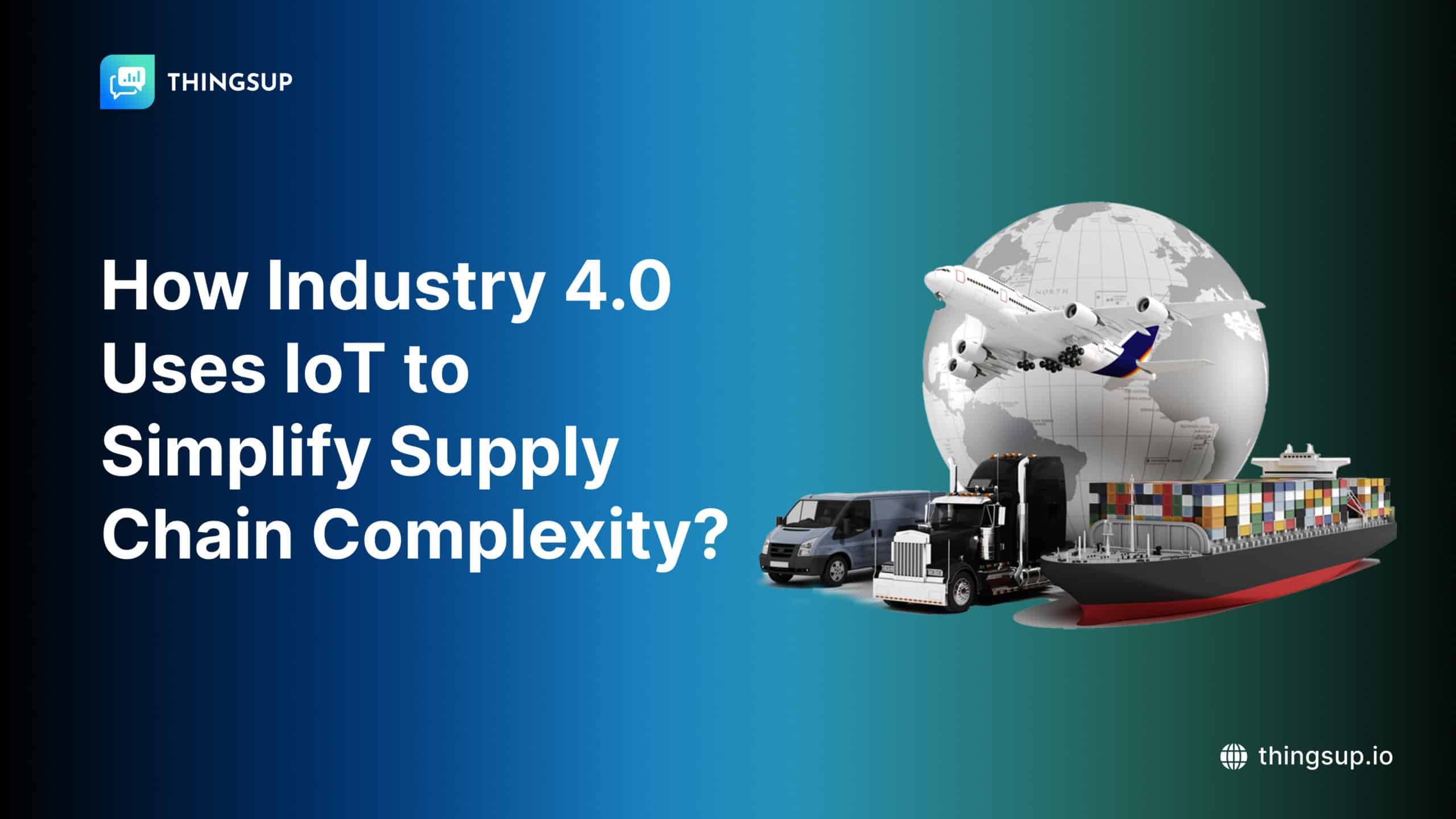With the arrival of Industry 4.0, many sectors have witnessed changes, and the supply chain is no exception.
As advanced technologies such as IoT, AI, Big Data, etc., are gaining ground in the market, it has become easier for businesses to run their operations. Not only this, these technologies have strengthened the decision-making capability of businesses and have also given businesses the ability to reduce their risks in real time.
The usage of IoT in supply chain management has increased significantly. All the complexities that businesses used to face in logistics, vendor management, and inventory control have now been reduced significantly due to IoT. Even we can say that they are almost nonexistent now.
In this blog post, we will understand how Industry 4.0 uses IoT to make the supply chain less complicated and its possible future effects.
The Complexity of Modern Supply Chain
As the market grows, many new players are also entering the market. Overall, the supply chain is becoming a highly complex ecosystem. In this ecosystem, you will see multiple players, such as raw material suppliers, manufacturers, distributors, and retailers.
The interconnectedness between different sectors and stakeholders in the market has complicated the supply chain. Due to this, businesses may experience delays in shipments, inefficient processes and, unpredictable changes in demand, etc.
According to a report by Statista, 34% of businesses worldwide express disruptions in their supply chain as their primary concern when it comes to satisfying the demands of their customers.
Managing these complexities is very important for businesses, not for their processes but for their customers. As customers expect quicker deliveries and hassle-free operations. Here, Industry 4.0 and the Internet of Things (IoT) come into play.
What is The Role of IoT in Industry 4.0?
The term “Industry 4.0” refers to the fourth industrial revolution. It is distinguished by the utilization of intelligent automation and data sharing in the manufacturing sector. In this transformation, the Internet of Things platforms is at the center.
Here, IoT platform work like a bridge between the physical world and smart digital systems. Through which devices can easily send and receive data without any interruption.
It is possible to analyze this continuous flow of information to optimize the processes involved in the supply chain, thereby increasing efficiency and decreasing costs.
How IoT Simplifies Supply Chain Complexity?
IoT devices collect real-time data from different touch points across the supply chain. This provides two benefits to businesses. Primarily, their processes remain comprehensively transparent and secondly, they are easy to manage those processes. Below are the key areas where IoT simplifies supply chain complexity.
Real-Time Tracking and Visibility
The biggest and most immediate advantage for businesses using IoT in supply chain management is real-time tracking and visibility of their devices and processes.
Sensors attached to shipments provide real-time information on the shipment’s location, temperature, humidity and even vibration level. Thus, businesses transporting temperature-sensitive products like pharmaceuticals and food receive minute-to-minute information about the products, allowing them to prevent damage promptly.
Cold chain management is a significant application of IoT in such industries.
For example; IoT-enabled sensors actively monitor and manage the temperature of perishable goods during transportation or while stored in cold storage. This ensures compliance with safety regulations. Additionally, if the temperature falls below the threshold level during transportation, these systems alert businesses, enabling them to prevent product spoilage.
Cold Chain Monitoring Benefits | Description |
Automated alerts | Sends immediate alerts when temperature deviates from the set range |
Real-time monitoring | Enables 24/7 tracking of temperature-sensitive goods |
Compliance adherence | Ensures compliance with regulatory standards for perishable goods |
Reduced spoilage | Minimizes the risk of product loss due to temperature breaches |
According to a McKinsey report, companies using AI for supply chain management have improved logistics costs by 15% and service levels by 65%. These advancements allow companies to plan for delays and reroute shipments in case of any disruptions, improve customer satisfaction and reduce costs.
Inventory Management and Optimization
Inventory management has also become much simpler and optimized with IoT. Business owners no longer have to go through manual processes to get information about their stock data. IoT provides real-time information about the stocks.
IoT enabled systems can track inventory levels, their shelf life and the demand patterns of their product as per the market trends so that businesses can overcome the problems of stockout and overstocking.
IoT device management platform play a significant role here as businesses can easily manage multiple IoT devices, whether its sensor monitoring stock levels or RFID tags tracking product movements.
For example, a store can use an IoT device management platform to set up automatic reorder points. These reorder points enable stock to be restocked when a inventory level is reached.
Challenges in Inventory Management | How IoT Solves Them |
Inaccurate stock data | IoT sensors offer real-time stock visibility |
Stockouts or overstocking | Automated reordering ensures optimal inventory levels |
Manual intervention delays | Real-time monitoring reduces manual oversight |
Predictive Maintenance
As we discussed earlier, the supply chain is becoming more complex day by day. In this way IoT simplifies supply chain complexity with the help of predictive maintenance.
IoT simplifies supply chain complexity through predictive maintenance. Using IoT sensors on vehicles and machines to track their health in real time, predictive maintenance can figure out when those vehicles and equipment need maintenance.
This proactive approach can reduce downtime, reduce maintenance cost and even extend the lifetime of the machinery or equipment.
If we talk about the automotive supply chain, IoT sensors can track all kinds of vehicle problems like non-functioning equipment, etc. IoT sensors can prevent sudden machinery or equipment breakdowns and ensure timely delivery of goods to their destination.
Nowadays, more and more businesses are moving towards predictive maintenance. “According to Market.us, the Global Predictive Maintenance Market is expected to expand from USD 8.7 billion in 2023 to approximately USD 107.3 billion by 2033, achieving a compound annual growth rate (CAGR) of 28.5% during the forecast period from 2024 to 2033.”
Improved Data-Driven Decision Making
The right decision taken at the right time benefits to businesses, be it sales or inventory management. Data is very important for the management of inventory perfectly. Here IoT provides not just data but real-time data which businesses can take intelligently while making decisions related to their inventory.
For example; Analysts can examine historical data on shipment delays, temperature breaches in cold chain logistics, and vendor performance to identify patterns and take corrective action
Data analytics powered by IoT strengthen the business process by optimizing their supply chain by predicting the demand trends. Besides this IoT technology even identifies the weak points where businesses need to focus on. IoT devices provide insights that businesses can integrate with enterprise resource planning (ERP) systems to enhance end-to-end visibility of their supply chain operations.
IoT in Decision Making | Description |
Predictive analytics | Uses historical data to predict future supply chain disruptions |
Optimization algorithms | Automates complex decision-making tasks like route optimization |
Cost reduction | Identifies inefficiencies and reduces operational costs |
Automation and Robotics
The Internet of Things (IoT) and artificial intelligence (AI) are achieving greater levels of automation in supply chains daily. From Packing and sorting to even last-mile delivery can be done by robots that are equipped with Internet of Things sensors.
The best thing is, Internet of Things (IoT)-powered warehouse automation systems reduce the number of errors caused by humans. Along with that they speed up the process of fulfilling orders, and guarantee the quality throughout the whole process.
According to a survey by PwC, the deployment of robots and systems powered by the Internet of Things has the potential to increase labor productivity in warehouses by as much as 70 percent. As labor shortages continue to impact supply chain operations around the world, this is an extremely important development.
IoT and Sustainability in Supply Chains
The biggest focus in supply chain management is sustainability. Nowadays every business fulfills its environmental responsibilities by becoming environmentally conscious. In this way the supply chain is managed in a way that has as little impact on the environment as possible.
Internet of Things technologies play a major part in enabling more sustainable supply chains.
Through the reduction of waste, the improvement of energy efficiency, and the optimization of resource utilization.
For example, IoT sensors can monitor energy consumption in warehouses and production facilities. They identify the areas where energy is used more than required, and suggest improvements. In logistics, IoT-enabled route optimization helps suggest the shortest route from one place to another, which eliminates unnecessary travel and can reduce fuel consumption.
IoT-driven cold chain monitoring systems actively store and transport perishable goods to minimize spoilage and reduce food waste.
Sustainable IoT Applications | Description |
Energy monitoring | IoT sensors track energy consumption and suggest ways to improve efficiency |
Route optimization | Reduces fuel consumption and emissions by optimizing delivery routes |
Waste reduction | Cold chain monitoring systems minimize spoilage, reducing food waste |
Blockchain and IoT: The Transparency Enhancers
Combining blockchain technology with Internet of Things technologies is another rising trend in supply chain management. Through the integration of blockchain technology with the IoT, businesses can significantly improve the transparency and security of their supply chains.
While Internet of Things sensors provide real-time data on the condition and placement of items, blockchain technology maintains a permanent record of transactions.
In sectors with complex supply chains, like the pharmaceutical industry, it becomes very important for businesses to guarantee the credibility of products. Here, this combination of blockchain and IoT enhances the transparency of the whole process.
For example; Blockchain verifies the origin and quality of raw materials, while IoT sensors monitor the temperature and humidity of sensitive goods throughout the supply chain. This level of transparency helps businesses comply with regulations and build trust with their customers.
Blockchain and IoT in Supply Chains | Benefits |
Enhanced transparency | Provides real-time visibility into supply chain operations |
Improved security | Blockchain ensures that supply chain data is secure and tamper-proof |
Regulatory compliance | Helps businesses meet regulatory requirements by providing an auditable trail |
What is The Future of IoT in Supply Chain Management?
As IoT technology evolves, its impact on supply chain management will also grow. In the future, it may be integrated with blockchain technology to increase transparency. AI-driven analytics will get a further boost for more accurate demand forecasting. Along with this, 5G can be used to increase the speed and reliability of IoT devices.
Cold chain monitoring and other temperature-sensitive logistics applications will continue to evolve, with more businesses implementing IoT solutions to protect their assets and comply with regulations. Furthermore, device management platforms will become even more critical as businesses scale their IoT ecosystems to include thousands of connected devices.
Conclusion
As you know, the level of complexity in current supply chain management is increasing day by day. To deal with these, there is a great need for innovative solutions. In this situation, industry 4.0’s use of IoT provides a comprehensive approach to streamlining operations. The Internet of Things takes away some of the complexities involved in global logistics and supply chain management. This is done through real-time tracking, predictive maintenance, inventory optimization, and decision-making that is driven by data.
By adopting IoT platforms, businesses can not only improve their supply chain visibility but also reduce risks with the help of real-time data, which will have a positive impact on the overall efficiency of businesses in the long run.






